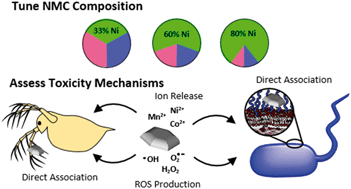Nickel enrichment of next-generation NMC nanomaterials alters material stability, causing unexpected dissolution behavior and observed toxicity to S. oneidensis MR-1 and D. magna†
Abstract
Lithium intercalation compounds, such as the complex metal oxide, lithium nickel manganese cobalt oxide (LiNixMnyCo1−x−yO2, herein referred to as NMC), have demonstrated their utility as energy storage materials. In response to recent concerns about the global supply of cobalt, industrially synthesized NMCs are shifting toward using NMC compositions with enriched nickel content. However, nickel is one of the more toxic components of NMC materials, meriting investigation of the toxicity of these materials on environmentally relevant organisms. Herein, the toxicity of both nanoscale and microscale Ni-enriched NMCs to the bacterium, Shewanella oneidensis MR-1, and the zooplankton, Daphnia magna, was assessed. Unexpectedly, for the bacteria, all NMC materials exhibited similar toxicity when used at equal surface area-based doses, despite the different nickel content in each. Material dissolution to toxic species, namely nickel and cobalt ions, was therefore modelled using a combined density functional theory and thermodynamics approach, which showed an increase in material stability due to the Ni-enriched material containing nickel with an oxidation state >2. The increased stability of this material means that similar dissolution is expected between Ni-enriched NMC and equistoichiometric NMC, which is what was found in experiments. For S. oneidensis, the toxicity of the released ions recapitulated toxicity of NMC nanoparticles. For D. magna, nickel enrichment increased the observed toxicity of NMC, but this toxicity was not due to ion release. Association of the NMC was observed with both S. oneidensis and D. magna. This work demonstrates that for organisms where the major mode of toxicity is based on ion release, including more nickel in NMC does not impact toxicity due to increased particle stability; however, for organisms where the core composition dictates the toxicity, including more nickel in the redesign strategy may lead to greater toxicity due to nanoparticle-specific impacts on the organism.



 Please wait while we load your content...
Please wait while we load your content...
